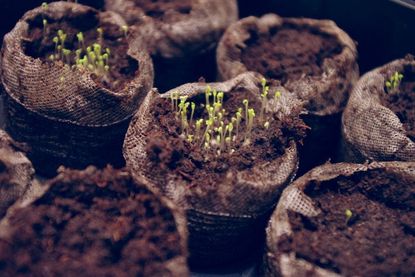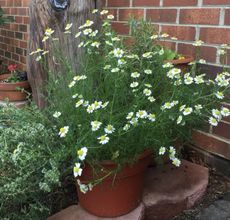Chamomile Seed Info: How And When To Plant Chamomile Seeds


Chamomiles are cheery little plants. Sweetly scented like fresh apples, chamomile plants are used as ornamental flowerbed borders, planted in cottage and herb gardens, or grown as a pollinator friendly, low-maintenance lawn substitute. They are also used as a defense against pests and disease in the vegetable garden. Chamomile plants may range in height from 6 to 18 inches (15-46 cm.) with an equal spread, depending upon the type. All chamomile types produce an abundance of seed that will quickly self-sow wherever it lands in warm, loose soil. Continue reading to learn more about growing chamomile from seed.
How to Grow Chamomile from Seed
There are two different species of plants commonly known as chamomile.
- Chamaemelum mobile, also commonly known as English, Russian, or Roman chamomile, is a low-growing perennial. It is considered to be the true chamomile and is used in landscapes as a flowering groundcover or lawn substitute. English chamomile is hardy in zones 4 through 11 and is cultivated all over the world for its herbal properties.
- German chamomile, or Matricaria recutita, is also cultivated as the herb chamomile, but it is considered the false chamomile. It is an annual that grows to 18 inches (46 cm.) tall and its consistent, miniature, daisy like flowers add charm to the container, herb, and cottage gardens.
Both types of chamomile plants produce small, white, composite flowers with bright yellow center discs. German chamomile produces a hollow conical disc from which its white petals arch down from. English chamomile’s disc is flatter and solid, the flower petals spread outward from the disc, like a ray. Upon each disc, or seed head, an abundance of chamomile seeds are produced, which germinate within seven to ten days when exposed to adequate soil, sunlight, and water. When seeds are left on the plant to mature and spread naturally, one chamomile plant can quickly turn into a lovely patch of chamomile.
Planting Chamomile Seeds
Chamomile usually produces flowers that can be harvested for herbal use in just six to eight weeks. When harvesting chamomile flowers, most herb gardeners will leave some seed heads to naturally self-sow to produce a small colony of chamomile. You can also set aside some of the harvested blooms to dry for seed to plant in other areas. So, when to plant chamomile seeds in the garden? Chamomile seeds can be started indoors three to four weeks before the last frost. When planting chamomile seeds indoors, fill a seed tray with a well-draining potting mix, then simply scatter the seeds over the loose soil and lightly tamp it down or water it in with a light mist. Seedlings should be thinned 2 to 4 inches (5-10 cm.) apart when they are about an inch (2.5 cm.) tall. Plants do not like to be transplanted once their roots have been established and they begin to produce blooms, so many gardeners prefer to sow the seeds directly in the garden. In the garden or as a lawn substitute, chamomile seeds need only be scattered over loose soil and gently tamped down. Germination can occur in temperatures as low as 45 to 55 degrees F. (7-13 C.) in full sun to part shade.
Gardening tips, videos, info and more delivered right to your inbox!
Sign up for the Gardening Know How newsletter today and receive a free download of our most popular eBook "How to Grow Delicious Tomatoes."
-
 Urban Beekeeping Guide: Top Tips For Raising Bees In The City
Urban Beekeeping Guide: Top Tips For Raising Bees In The CityUrban beekeeping can be a rewarding and appreciated pastime, but first be sure it’s legal in your city and learn the ropes of beekeeping.
By Mary Ellen Ellis
-
 2024 Plant Of The Year: Why Experts Say Philodendron Is The “It” Plant Of The Year
2024 Plant Of The Year: Why Experts Say Philodendron Is The “It” Plant Of The YearWe aren’t surprised that philodendron was designated the plant of the year. Versatile, easy-care and lovely, it’s the houseplant of the year 2024!
By Bonnie L. Grant
-
 How To Dry Chamomile Plants – Tips For Drying Chamomile Flowers
How To Dry Chamomile Plants – Tips For Drying Chamomile FlowersChamomile, unlike other herbs, is harvested just for its lovely, daisy-like flowers, which are then preserved. Chamomile preservation basically means drying the chamomile flowers. There are four chamomile drying techniques. Click here to find out how to dry chamomile.
By Amy Grant
-
 Chamomile Not Flowering: Why Won’t My Chamomile Bloom
Chamomile Not Flowering: Why Won’t My Chamomile BloomChamomile is usually the go-to remedy for so many things, but what can you go to when it is a chamomile plant that needs a remedy - for example, how to make a chamomile plant flower if it's not. Learn more about non-blooming in chamomile here.
By Darcy Larum
-
 Roman Vs. German Chamomile – Learn About Different Types Of Chamomile
Roman Vs. German Chamomile – Learn About Different Types Of ChamomileIf you're so fond of the tea that you decide to grow chamomile in your own garden, you may be surprised to find that there are different types of seeds and plants available. Click here to learn about distinguishing between different chamomile varieties.
By Darcy Larum
-
 Potted Chamomile Plants – How To Grow Chamomile In A Container
Potted Chamomile Plants – How To Grow Chamomile In A ContainerGrowing chamomile in containers is perfect if you're worried the generous self-seeder may be too rambunctious in the garden. Click fore more.
By Mary H. Dyer
-
 Is Chamomile Edible – Learn About Edible Chamomile Uses
Is Chamomile Edible – Learn About Edible Chamomile UsesTraditionally, many generations have appreciated chamomile for its curative qualities, and to this day, people rely on chamomile tea to calm frazzled nerves and relax at bedtime. But is chamomile edible, and if so, what parts of chamomile are edible? Find out here.
By Mary H. Dyer
-
 Harvesting Chamomile Plants: When To Pick Chamomile Flowers
Harvesting Chamomile Plants: When To Pick Chamomile FlowersChamomile is useful for so many ailments and is easy to grow too, but how do you know when to pick chamomile? Not only do you need to know when to harvest chamomile, but how to harvest chamomile. Click this article to find out about picking chamomile plants.
By Amy Grant
-
 Growing Chamomile Tea: Making Tea From Chamomile Plants
Growing Chamomile Tea: Making Tea From Chamomile PlantsIf you?ve never thought about growing your own chamomile tea plant for tea brewing, now?s the time. Chamomile is easy to grow and thrives in a variety of areas. Use the information from this article to find out how to grow chamomile for tea.
By Amy Grant
-
 Chamomile Tea For Gardening: Tips On Using Chamomile Tea In The Garden
Chamomile Tea For Gardening: Tips On Using Chamomile Tea In The GardenChamomile tea is a mild herbal tea often used for its calming effects and for its ability to calm mild stomach upsets. However, using chamomile tea for gardening may offer surprising benefits that most people haven?t considered. Learn more here.
By Mary H. Dyer